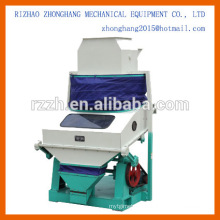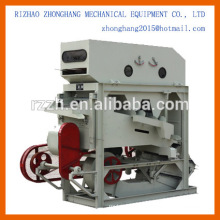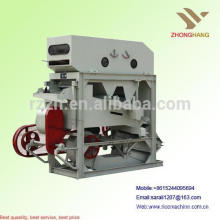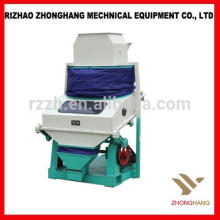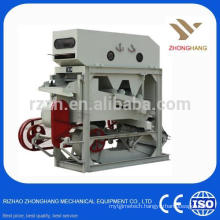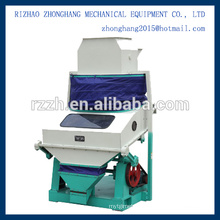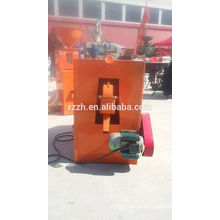Comprehensive recovery of phosphate ore dressing
2021-05-09
Most of phosphate mineral resources and associated symbiotic magnesium, iron, titanium, rare earth, iodine, fluorine, and other elements useful for high value-added, and fluorite, dolomite, diopside, biotite useful in non-metallic minerals, effective The recycling of phosphate ore and associated resources is of great significance for the conservation and protection of China's mineral resources, especially for the protection of strategic resources such as titanium, rare earth and fluorite. In recent years, phosphate ore dressing workers have carried out more research work on comprehensive recovery of phosphate mines and associated resources, and have achieved relatively rich results.
Huang Fang et al. treated the characteristics of a phosphate rock flotation tailings as high-magnesium low-grade phosphate rock, and separated the magnesium and phosphorus in the acid leaching solution by extraction-back extraction. Select n-butanol as the extractant, and the extraction rate of P2O5 can reach 68% or more under the equilibrium stirring condition of the mass fraction of phosphoric acid of 30%, the extraction ratio of 1..1, the temperature of normal temperature and the extraction time of 5 min; The stripping agent is added in an amount of 30% of the volume of the organic phase before stripping, and the stripping time is 3 min. The stripping is carried out under normal temperature conditions, and the stripping rate is over 90%. This study provides basic information for the comprehensive recovery of phosphate rock flotation tailings.
Ma Kai and Liu Shuhai conducted an experimental study on the direct decomposition of phosphate rock flotation tailings with hydrochloric acid in order to utilize by-product hydrochloric acid and recycle phosphorus in flotation tailings. The orthogonal design was used to study the effects of hydrochloric acid mass fraction, hydrochloric acid dosage, reaction temperature and reaction time on the phosphorus dissolution rate in tailings. The obtained phosphoric acid hydrolysate was used to prepare NP fertilizer with ammonia water. Finally, the energy was reduced. Consumption and material consumption Discussed the appropriate process conditions for the decomposition of tailings by hydrochloric acid.
Luo Huihua et al. disclose a method for preparing light magnesium oxide by using phosphorus ore reverse flotation demagnetization tailings: dissolving phosphate rock reverse flotation demagnesing tailings in hydrochloric acid solution, adding oxidant, heating to 50~80 °C and Adjust the pH value to 5~7, filter to obtain the filtrate, add ammonia water to adjust the pH value to 10~11 to form a precipitate, filter to obtain filter residue, and the obtained filter residue is washed, dried and calcined to obtain light magnesium oxide powder.
Jin Huixin et al. used the reverse flotation process to study the effects of factors such as the type and amount of inhibitor, the amount of collector WF-01, flotation time, slurry mass fraction and fineness of grinding on the flotation of Xinhua rare earth phosphate rock. Influence, and the rare earth analysis of the phosphate concentrate and tailings obtained under the better flotation conditions. The results show that the flotation agent is WF-01, industrial sulfuric acid is not suitable as the inhibitor of phosphorus mineral in the flotation of the ore sample, and industrial phosphoric acid is used as the inhibitor and the pH adjuster of the pulp. The amount of phosphoric acid is 9 kg/ t, collector WF-01 dosage 0.8 kg / t, flotation time 9 min, grinding fineness -74 μm mass fraction accounted for 82%, pulp mass fraction 35% of the flotation conditions, you can get better float With the effect of rare earth enrichment, the P2O5 grade of phosphate concentrate can be increased from 21.71% to more than 32% of the ore, and the recovery rate is 90%. During the flotation process, the rare earth is mainly enriched in the phosphate concentrate, and the enrichment ratio is 1.56, the recovery rate in concentrate is 87.09%.
In order to comprehensively utilize minerals such as apatite, diopside, biotite, iron ore and other minerals in Shangzhuang Phosphorus Mine in Ping'an County, Qinghai Province, Sun Xiaohua and Others have adopted a low-cost re-election-magnetic separation process. Phosphorus concentrate with P2O5 of 31.0% was selected from the original ore with P2O5 grade of 3.44%. At the same time, biotite and pyroxene products with mineral content of 31.06% and 51.14% were recovered, and iron concentrate containing 68.20% TFe was obtained. The mine provides reasonable mineral processing methods and technical indicators for the development and utilization of the mining area.
Zhang Zhiqiang et al. introduced the experimental and research results of the properties and comprehensive utilization of a large low-grade metamorphic rock type phosphate deposit in North China. The mass fractions of P2O5, TiO2 and magnetic iron in the ore were 4.01%, 5.00% and 4.24%, respectively. The flotation, weak magnetic separation and re-election-strong magnetic separation principle process can effectively recover the useful minerals in the ore including apatite, magnetite and ilmenite, and the grade/recycling of the three concentrate products. The rates were 36.08%/95.58%, 66.11%/29.75%, and 45.00%/41.O8%, respectively.
Huang Fang et al. treated the phosphorus tailings as a high-phosphorus dolomite ore, abandoned the traditional dolomite carbonization method, and proposed a calcination-ammonium salt selective leaching process. Developed high-quality magnesium hydroxide, magnesium oxide and light calcium carbonate with high added value and industrial application prospects, and can obtain phosphorus concentrate suitable for wet-process phosphoric acid production, and better realize comprehensive utilization of resources. The research shows that when the calcination temperature is 900 °C, the dolomite in the tailings decomposes, while the calcium fluorophosphate does not decompose; the calcined clinker is leached with ammonium nitrate, the leaching rate of CaO can reach 80.43%; the leaching slag is leached with ammonium sulfate twice. The leaching rate of MgO can reach over 91%, and the secondary leaching slag is a phosphate concentrate containing more than 38% P2O5. The recovery rate of P2O5 is 88.58%. This study provides basic information for the comprehensive utilization of phosphate rock flotation tailings.
Zeng Bo et al. developed a method for preparing phosphorus-magnesium fertilizer by using low-grade phosphate ore flotation tailings as raw material and using sulfur-phosphorus mixed acid to directly decompose flotation tailings. The mineral characteristics of flotation tailings, the basic principle, process conditions and product quality of phosphorus-magnesium fertilizer for the preparation of phosphorus-magnesium fertilizer by sulfur-phosphorus mixed acid decomposition are described. The feasibility of preparing phosphorus-magnesium fertilizer for low-grade phosphate ore flotation tailings is demonstrated. .
Huang Fang et al. used the Guizhou Fufu Phosphorus tailings as the research object, leaching out by acid method, enriching P2O5 in acid hydrolysis solution, and purifying the enrichment solution in order to provide comprehensive recovery of phosphorus and magnesium in tailings. The necessary basis. Studies have shown that 5 to 6 cycles of leaching, P2O5 concentration in acid solution can reach 80 g / L, MgO mass concentration can reach 190 g / L or more, which is conducive to further recovery; reaction temperature 60 °C, reaction time 2 h, the amount of sodium carbonate added is the theoretical calculation amount, the amount of phosphorus tailings added is 120% of the theoretical addition amount, and the amount of phosphorus pentasulfide added is the theoretical addition amount, the defluorination rate is 85.7 %, the desulfurization rate is 80.1%, purification The mass fraction of Pb3+ in the post solution is 4.8×10 -4 %, and the mass fraction of As3+ is 11.3×10 -4 %, which is similar to the effect of defluorination, desulfurization and de-heavy metals on the enriched solution, respectively. Purification requirements.
Lei Xuelian et al. proposed a method for iodine crystallization in the process of extracting iodine from iodine-containing ores: (1) using a special iodine separation tank for iodine crystallization; (2) controlling iodine extraction during production operations The liquid level, temperature and concentration of the absorption liquid in the tank; (3) Adding an oxidant in the iodine removal tank and pre-oxidation under stirring; (4) Then adding the oxidant with a constant flow pump, and performing secondary oxidation under stirring, finally making the elemental Iodine crystals. Compared with the prior art, the present invention adopts a special iodine-discharging device, and according to the characteristics of the iodine crystallization process, the oxidizing agent is used for the secondary oxidation, and the crystal form of the iodine crystal can be controlled to generate crystals of different specifications; By changing the frequency of the agitator, the crystallization rate can be increased and the product quality can be effectively improved. Applicable to the production of iodine from phosphate rock.
In order to promote the development and utilization of phosphate resources associated with phosphate rock, Wang Wei analyzed the purification of fluorine-containing waste gas produced by chemical processing of phosphate rock and the method of fluorine recovery, and the production of a series of inorganic fluorine products by utilizing phosphorus chemical by-product fluorosilicic acid. The method and use were systematically elaborated. The new process of direct production of anhydrous hydrogen fluoride to produce ammonium fluoride and white carbon black was introduced, and the production method and process flow were briefly described. This indicates that: the development and utilization of phosphate-related phosphorus resources can not only control fluorine pollution, but also produce inorganic fluorine products by-product, thereby improving the comprehensive utilization efficiency of phosphate rock.
If you want to know more about the products in Comprehensive recovery of phosphate ore dressing, please click the product details to view parameters, models, pictures, prices and other information about Electrolyte Additive,Iodine Crystal Granule Crystal,Iodine Crystal,Cas 7553-56-2.
Whatever you are a group or individual, we will do our best to provide you with accurate and comprehensive message about Comprehensive recovery of phosphate ore dressing!
Electrolyte Additive, Iodine Crystal Granule Crystal, Iodine Crystal, Cas 7553-56-2
SKS International Trading Company Limited http://www.spirulina-yj.com

